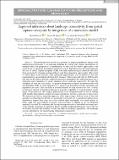Files in this item
Improved inferences about landscape connectivity from spatial capture–recapture by integration of a movement model
Item metadata
| dc.contributor.author | Dupont, Gates | |
| dc.contributor.author | Linden, Daniel W | |
| dc.contributor.author | Sutherland, Chris | |
| dc.date.accessioned | 2021-11-10T14:30:01Z | |
| dc.date.available | 2021-11-10T14:30:01Z | |
| dc.date.issued | 2021-11-10 | |
| dc.identifier | 276241779 | |
| dc.identifier | 22529d68-5ab3-43a7-8f6c-bcd1040c2235 | |
| dc.identifier | 85118860981 | |
| dc.identifier | 000716397900001 | |
| dc.identifier.citation | Dupont , G , Linden , D W & Sutherland , C 2021 , ' Improved inferences about landscape connectivity from spatial capture–recapture by integration of a movement model ' , Ecology , vol. Early View , e03544 . https://doi.org/10.1002/ecy.3544 | en |
| dc.identifier.issn | 0012-9658 | |
| dc.identifier.other | ORCID: /0000-0003-2073-1751/work/103138142 | |
| dc.identifier.uri | https://hdl.handle.net/10023/24305 | |
| dc.description.abstract | Understanding how broad-scale patterns in animal populations emerge from individual-level processes is an enduring challenge in ecology that requires investigation at multiple scales and perspectives. Complementary to this need for diverse approaches is the recent focus on integrated modeling in statistical ecology. Population-level processes represent the core of spatial capture–recapture (SCR), with many methodological extensions that have been motivated by standing ecological theory and data integration opportunities. The extent to which these recent advances offer inferential improvements can be limited by the data requirements for quantifying individual-level processes. This is especially true for SCR models that use non-Euclidean distance to relax the restrictive assumption that individual space use is stationary and symmetrical in order to make inferences about landscape connectivity. To meet the challenges of scale and data quality, we propose integrating an explicit movement model with non-Euclidean SCR for joint estimation of a shared cost parameter between individual and population processes. Here, we define a movement kernel for step selection that uses “ecological distance” instead of Euclidean distance to quantify availability for each movement step in terms of landscape cost. We compare performance of our integrated model to that of existing SCR models using realistic animal movement simulations and data collected on black bears. We demonstrate that an integrated approach offers improvements both in terms of bias and precision in estimating the shared cost parameter over models fit to spatial encounters alone. Simulations suggest these gains were only realized when step lengths were small relative to home range size, and estimates of density were insensitive to whether or not an integrated approach was used. By combining the fine spatiotemporal scale of individual movement processes with the estimation of population density in SCR, integrated approaches such as the one we develop here have the potential to unify the fields of movement, population, and landscape ecology and improve our understanding of landscape connectivity. | |
| dc.format.extent | 11 | |
| dc.format.extent | 957049 | |
| dc.language.iso | eng | |
| dc.relation.ispartof | Ecology | en |
| dc.subject | Animal movement | en |
| dc.subject | Connectivity | en |
| dc.subject | Cost function | en |
| dc.subject | Data integration | en |
| dc.subject | Spatial capture-recapture | en |
| dc.subject | QA Mathematics | en |
| dc.subject | QH301 Biology | en |
| dc.subject | DAS | en |
| dc.subject.lcc | QA | en |
| dc.subject.lcc | QH301 | en |
| dc.title | Improved inferences about landscape connectivity from spatial capture–recapture by integration of a movement model | en |
| dc.type | Journal article | en |
| dc.contributor.institution | University of St Andrews. Statistics | en |
| dc.contributor.institution | University of St Andrews. Centre for Research into Ecological & Environmental Modelling | en |
| dc.identifier.doi | 10.1002/ecy.3544 | |
| dc.description.status | Peer reviewed | en |
This item appears in the following Collection(s)
Items in the St Andrews Research Repository are protected by copyright, with all rights reserved, unless otherwise indicated.

